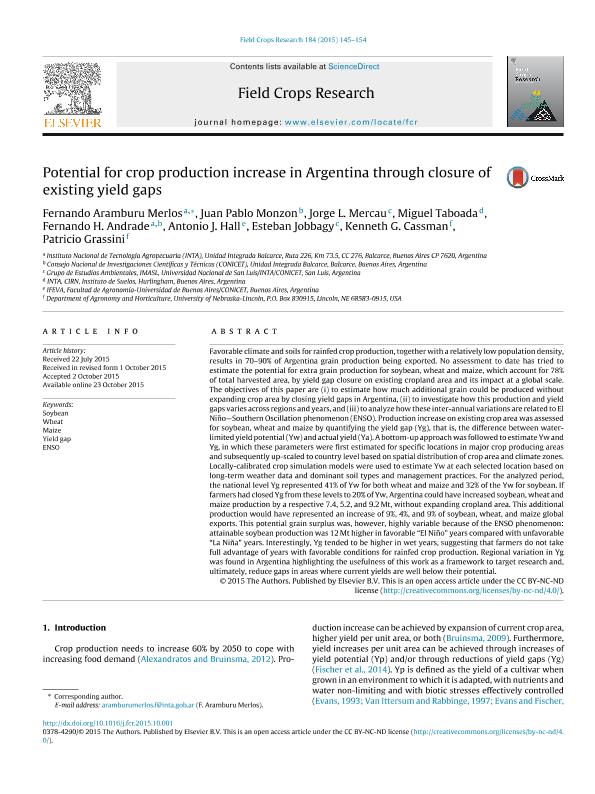Artículo
Potential for crop production increase in Argentina through closure of existing yield gaps
Aramburu Merlos, Fernando; Monzon, Juan Pablo ; Mercau, Jorge Luis; Taboada, Miguel Angel
; Mercau, Jorge Luis; Taboada, Miguel Angel ; Andrade, Fernando Héctor
; Andrade, Fernando Héctor ; Hall, Antonio Juan
; Hall, Antonio Juan ; Jobbagy Gampel, Esteban Gabriel
; Jobbagy Gampel, Esteban Gabriel ; Cassman, Kenneth G.; Grassini, Patricio
; Cassman, Kenneth G.; Grassini, Patricio
 ; Mercau, Jorge Luis; Taboada, Miguel Angel
; Mercau, Jorge Luis; Taboada, Miguel Angel ; Andrade, Fernando Héctor
; Andrade, Fernando Héctor ; Hall, Antonio Juan
; Hall, Antonio Juan ; Jobbagy Gampel, Esteban Gabriel
; Jobbagy Gampel, Esteban Gabriel ; Cassman, Kenneth G.; Grassini, Patricio
; Cassman, Kenneth G.; Grassini, Patricio
Fecha de publicación:
12/2015
Editorial:
Elsevier Science
Revista:
Field Crops Research
ISSN:
0378-4290
Idioma:
Inglés
Tipo de recurso:
Artículo publicado
Clasificación temática:
Resumen
Favorable climate and soils for rainfed crop production, together with a relatively low population density, results in 70-90% of Argentina grain production being exported. No assessment to date has tried to estimate the potential for extra grain production for soybean, wheat and maize, which account for 78% of total harvested area, by yield gap closure on existing cropland area and its impact at a global scale. The objectives of this paper are (i) to estimate how much additional grain could be produced without expanding crop area by closing yield gaps in Argentina, (ii) to investigate how this production and yield gaps varies across regions and years, and (iii) to analyze how these inter-annual variations are related to El Niño-Southern Oscillation phenomenon (ENSO). Production increase on existing crop area was assessed for soybean, wheat and maize by quantifying the yield gap (Yg), that is, the difference between water-limited yield potential (Yw) and actual yield (Ya). A bottom-up approach was followed to estimate Yw and Yg, in which these parameters were first estimated for specific locations in major crop producing areas and subsequently up-scaled to country level based on spatial distribution of crop area and climate zones. Locally-calibrated crop simulation models were used to estimate Yw at each selected location based on long-term weather data and dominant soil types and management practices. For the analyzed period, the national level Yg represented 41% of Yw for both wheat and maize and 32% of the Yw for soybean. If farmers had closed Yg from these levels to 20% of Yw, Argentina could have increased soybean, wheat and maize production by a respective 7.4, 5.2, and 9.2. Mt, without expanding cropland area. This additional production would have represented an increase of 9%, 4%, and 9% of soybean, wheat, and maize global exports. This potential grain surplus was, however, highly variable because of the ENSO phenomenon: attainable soybean production was 12. Mt higher in favorable "El Niño" years compared with unfavorable "La Niña" years. Interestingly, Yg tended to be higher in wet years, suggesting that farmers do not take full advantage of years with favorable conditions for rainfed crop production. Regional variation in Yg was found in Argentina highlighting the usefulness of this work as a framework to target research and, ultimately, reduce gaps in areas where current yields are well below their potential.
Archivos asociados
Licencia
Identificadores
Colecciones
Articulos(CCT - MAR DEL PLATA)
Articulos de CTRO.CIENTIFICO TECNOL.CONICET - MAR DEL PLATA
Articulos de CTRO.CIENTIFICO TECNOL.CONICET - MAR DEL PLATA
Articulos(IMASL)
Articulos de INST. DE MATEMATICA APLICADA DE SAN LUIS
Articulos de INST. DE MATEMATICA APLICADA DE SAN LUIS
Citación
Aramburu Merlos, Fernando; Monzon, Juan Pablo; Mercau, Jorge Luis; Taboada, Miguel Angel; Andrade, Fernando Héctor; et al.; Potential for crop production increase in Argentina through closure of existing yield gaps; Elsevier Science; Field Crops Research; 184; 12-2015; 145-154
Compartir
Altmétricas



